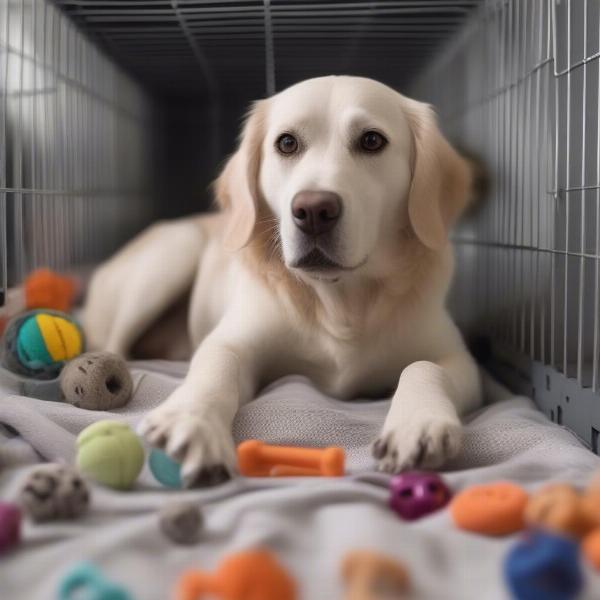Dealing with a dog that won’t stop barking in their crate can be frustrating for both you and your furry friend. It’s a common problem, especially for puppies or newly adopted dogs, and understanding the underlying reasons is key to finding a solution. Whether it’s separation anxiety, boredom, or a need for potty breaks, this article will explore the common causes of crate barking and provide practical, expert-backed solutions to help you create a peaceful environment for everyone.
Why is My Dog Barking in the Crate?
Several factors can contribute to excessive crate barking. It’s important to identify the root cause to address the issue effectively. Is your dog barking constantly, or only at certain times? Observing your dog’s behavior can offer valuable clues.
-
Separation Anxiety: This is a common reason for crate barking. Dogs with separation anxiety become distressed when left alone and express this through barking, whining, and destructive behavior.
-
Boredom and Lack of Stimulation: Crates can become boring for dogs, especially if they’re confined for extended periods without any mental or physical stimulation.
-
Potty Needs: A dog might bark in their crate if they need to go outside to relieve themselves. This is especially true for puppies who are still learning to control their bladder and bowels.
-
Medical Issues: In rare cases, underlying medical conditions can cause discomfort and lead to barking. If your dog’s barking is sudden and accompanied by other symptoms, consult a veterinarian.
-
Fear or Phobias: Loud noises, thunderstorms, or other environmental factors can trigger fear and anxiety, leading to barking in the crate.
How to Stop a Dog from Barking in a Crate
Addressing crate barking requires patience and consistency. Here’s a step-by-step guide to help you tackle this issue:
-
Ensure Proper Crate Training: A positive crate training experience is crucial. Introduce the crate gradually, making it a comfortable and safe space with positive associations.
-
Create a Comfortable Crate Environment: Provide your dog with soft bedding, familiar toys, and perhaps a blanket with your scent. Ensure the crate is in a quiet, low-traffic area of your home.
-
Establish a Potty Routine: Take your dog out for potty breaks regularly, especially before and after crate time. This can prevent accidents and minimize barking related to potty needs.
-
Provide Mental and Physical Stimulation: A tired dog is less likely to bark. Engage your dog in regular exercise and provide puzzle toys or chew toys to keep them occupied in the crate.
-
Ignore the Barking (Sometimes): If you suspect your dog is barking for attention, ignoring the behavior can be effective. Only acknowledge and reward them when they are quiet.
 Dog in Crate with Toys
Dog in Crate with Toys
Addressing Separation Anxiety in Crate-Trained Dogs
If separation anxiety is the cause of the barking, additional steps are necessary:
-
Desensitization and Counterconditioning: Gradually desensitize your dog to your departure by practicing short absences and gradually increasing the duration. Pair your departure with positive experiences, such as treats or toys.
-
Consult a Veterinarian or Certified Dog Trainer: For severe separation anxiety, professional guidance from a veterinarian or certified dog trainer can be invaluable. They can recommend specific behavior modification techniques tailored to your dog’s needs.
Expert Insights on Crate Barking
“Crate training should always be a positive experience for your dog,” says Dr. Emily Carter, a veterinary behaviorist. “A properly trained dog will see their crate as a safe haven, not a punishment.” Creating a positive association with the crate from the start is crucial for success.
Jane Miller, a certified dog trainer, adds, “Consistency is key. Stick to a routine and avoid inadvertently reinforcing the barking behavior.” Ignoring attention-seeking barks and rewarding quiet moments can help your dog learn the desired behavior.
Conclusion
Addressing crate barking requires understanding the underlying cause and implementing appropriate strategies. With patience, consistency, and a focus on creating a positive crate environment, you can help your furry friend feel comfortable and secure, leading to a quieter and happier home for everyone. Remember to consider your dog’s individual needs and consult with a professional if necessary.
FAQ
-
How long can I leave my dog in a crate? This depends on your dog’s age, bladder control, and individual needs. Puppies generally require more frequent breaks.
-
Is it cruel to crate train a dog? No, crate training is not inherently cruel. When done correctly, it provides a safe and secure space for your dog.
-
What if my dog continues to bark despite my efforts? Consult with a veterinarian or certified dog trainer for further guidance. They can help identify underlying issues and recommend tailored solutions.
-
Can I use a bark collar to stop crate barking? Bark collars are generally not recommended as they can exacerbate anxiety and address the symptom, not the cause.
-
How can I make my dog’s crate more comfortable? Provide soft bedding, familiar toys, and consider covering the crate to create a den-like environment.
-
Should I punish my dog for barking in the crate? Punishment is counterproductive and can worsen anxiety. Focus on positive reinforcement and addressing the underlying cause of the barking.
Related Articles
About ILM Dog
ILM Dog (ilmdog.com) is your trusted resource for expert advice on dog care, covering everything from breed selection and training to health and nutrition. We are passionate about providing practical, evidence-based information to help dog owners worldwide provide the best possible care for their furry companions. Whether you are a new dog owner or a seasoned expert, ILM Dog has the resources you need, including guidance on dog behavior and training. Contact us today for personalized advice: [email protected] | +44 20-3965-8624.